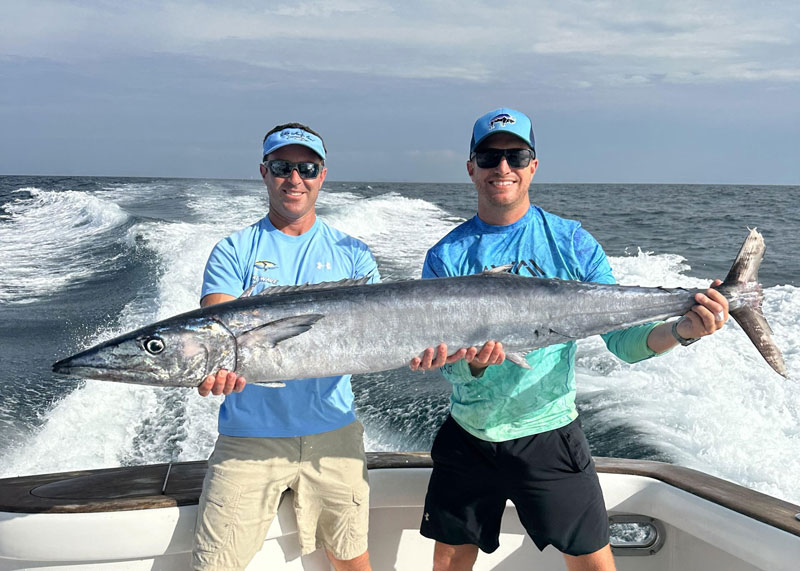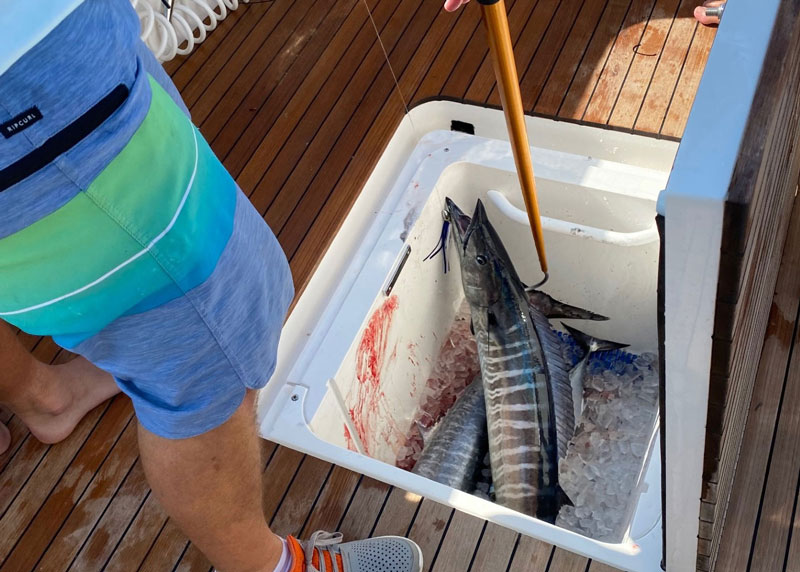An October wahoo will slice off hooks and lures faster than you can read a single word in this sentence, hit inline swivels to de-rig your line, shake free even when solidly hooked, and are tougher to gaff than an eel. They have a near-mythical status as Houdini-like escape artists, causing endless frustration for the anglers that pursue them. Still, we target these toothy, tasty underwater missiles, even as some anglers go entire seasons with one-to-five to one-to-10 success ratios. If you want to stop hoping and start grilling, apply these tips and tricks to hopefully go home happy.

- Time your trip right – Troll offshore of the DelMarVa coast whenever and you might see a wahoo or two. Troll in October and you might see a half-dozen in one day. For whatever quirky reason Mother Nature conjured up we don’t generally see a concentrated run of these fish in the spring, but once October hits (and into November) their numbers in this neck of the woods multiply. Yes, finding a weather window can be tough and no, a fall run isn’t a guaranteed thing, but if you really want to bag a Hoodini or two the next month to six weeks is usually prime time.
- Stay inshore – While there are certainly wahoo at the canyons, inshore lumps 30 to 50 miles out are usually a better bet. Naturally this can vary from season to season, and in some cases sticking inshore will mean reducing the chances of encountering tunas and/or billfish. But if you really want those wahoo you need to focus in on them like a laser.
- Focus on structure, including and beyond those lumps – Work edges and drops but also look for weedlines, temperature breaks, and flotsam. Wahoo do congregate around this stuff more or less as mahi-mahi do, though generally not in schools so large. Though it can be a hassle to troll through patchy weeds and constantly shuck your offerings, you can bet the chances are better you’ll pull your offerings past larger numbers of fish. When planning your trip ID a trolling pattern that takes you across a series of lumps or range widely over a larger lump and keep your eyes peeled for this sort of secondary structure. When you find it, work the area thoroughly.
- Get some lines down deep –Wahoo will hit baits pulled across the surface, but you’ll have much better chances of getting a strike if you get some lures down 15’, 20’, or even 30’ below the surface. In some areas anglers rig up huge inline weights, which certainly works, but does put a lot of stress on your gear and takes a lot of the fight out of the equation. Another option is running diving plugs like Marauders. Even better is pulling a “poor man’s downrigger.” This consists of a high-speed planer like a Sea Striker #8 on 40’ or 50’ of 300-lb test run from a stern cleat, with your fishing line tethered to the planer line on a break-away rig. Simply let out 25’ or 30’ on a fishing line, then bend a rubber band around the line and through the eye of a swivel, and clip the swivel around the planer line. Put the reel into freespool and as you let additional fishing line out water pressure will push the swivel down the planer line. When a fish strikes the rubber band will snap and set the line free. Keep extra swivels on hand, because after a strike the loose swivel will slide down the planer line and you won’t get it back until retrieving the planer at the end of the day.
- Goose the speed – Wahoo are known for liking a fast-moving bait, and you’ve probably heard about anglers targeting them at outrageous speeds up to 14 or 15 mph. But you certainly don’t have to be moving at speeds anything like that to get them to strike (and doing so requires serious gear adjustments). In the regions where these tactics are commonly used the fish tend to be scattered over wide areas, as opposed to concentrated over or around structure, and it’s a way of covering a ton of ground while you seek out the fish. Here, when they’re concentrated on the lumps and structure, that much speed isn’t necessary. That said, bumping up to eight knots is a good move. Trolling any faster leads to problems like ripped ballyhoo, swimming plugs running sideways, and creeping drags, but an extra knot or two of speed does boost your chances.

Were you hoping 2024 would be your season of the wahoo? We can’t predict what this fall’s run will be like, but one thing is for sure: the next six to eight weeks are likely to give us the best wahoo fishing of the season, so now’s the best time to try putting one of these escape artists into fish-jail.
Bonus Wahoo Fishing Tip
In all cases remember that you’ll need a trace of wire in front of your offering or the wahoo’s razor-sharp teeth will make short work of whatever you might put out there. And, remember how we mentioned wahoo eating swivels? It does happen — these fish will hit anything flashy. Inline swivels (a must when trolling spoons) should be matte black, not bright silver.
Double-Bonus Wahoo Fishing Tip
Dark red, black, and purple skirted ballyhoo or five-inch spoons with prismatic tape in red or purple are good picks for baits, and dark colors in general do seem to generate more wahoo strikes than standard pinks, greens, and blues.